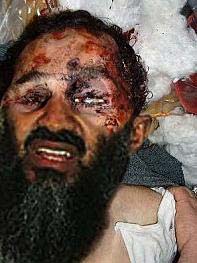Death of Osama bin Laden
On April 29, 2011, U.S. President Barack Obama authorized a raid ("Operation Neptune Spear" with "Geronimo" as the code name for bin Laden himself.) on bin Laden's suspected location near Abbottabad, Pakistan.
It was originally believed that bin Laden was hiding near the border between Afghanistan and Pakistan's Federally Administered Tribal Areas, but he was actually found 100 miles (160 km) away in a $250,000 three-story mansion in Abbottabad at 34°10′9.67″N 73°14′33.60″E.
Bin Laden's mansion was located 0.8 miles (1.3 km) southwest of the Pakistan Military Academy (Pakistan's "West Point"). Google Earth maps show that the compound was not present in 2001, but was present on images taken in 2005.
On May 1, 2011, in Washington, D.C. (May 2, Pakistan Standard Time), U.S. President Barack Obama announced that Osama bin Laden had been killed. The operation (dubbed Geronimo "E-KIA") was successfully carried out in the early morning of May 2 by U.S. Navy SEALs with intelligence support from the Central Intelligence Agency (CIA).
During the raid, bin Laden was fatally shot in the head and chest. The entire raid, including intelligence sweeps of the compound, was completed in less than 40 minutes. His body was taken and biometric facial recognition tests were performed. Subsequent genetic testing reportedly supported the preliminary identification.
Among those killed in the raid were one of bin Laden's sons, a man described as a courier, and the courier's brother. Four years of surveillance of the courier led to the intelligence which made the raid possible. It was reported that the courier was the owner of the compound where the assault took place.
The day after the raid John Brennan, the White House counterterrorism chief, said that the woman that was killed was one of bin Laden's four wives and was being used as a human shield at the time, though this claim was later retracted.
Two other women, who were also used as shields, were injured during the raid. He also said that the al-Qaeda leader put up resistance, but was unarmed. Bin Laden was shot twice. A shot above his left eye blew away a part of his skull. He was also hit in the chest.
Within 24 hours of his death, his body was transported to the aircraft carrier "USS Carl Vinson" for final rites and burial at sea. According to the United States military, the decision to bury his remains at sea was to circumvent international difficulties in choosing a burial site. Some observers at the time suggested it might also have been designed to prevent any physical enshrinement of the terrorist leader.
His death attracted protests from hundreds of people in the city of Quetta, in southwestern Pakistan, burning U.S. flags and paying homage to the late al-Qaeda leader. U.S. officials reported that a team of 24 U.S. Navy SEALs from the Naval Special Warfare Development Group (SEAL Team Six), under the command of the Joint Special Operations Command and working with the CIA, stormed bin Laden's compound in two helicopters.
Bin Laden, three other men, and a woman were killed in a firefight in which U.S. forces did not experience any injuries or casualties however one of the helicopters experienced mechanical difficulties, and was destroyed by the SEALs onsite. In his broadcast announcement President Obama said that U.S. forces "took care to avoid civilian casualties." According to U.S. officials, the attack was carried out without the knowledge or consent of Pakistani authorities.
DNA from bin Laden's body, compared with DNA samples on record from his dead sister's brain confirmed bin Laden's identity the following day according to assertions to ABC News by unnamed sources. The 193 cm long body was recovered by the U.S. military and was in its custody until his body was buried in the North Arabian Sea from the USS Carl Vinson, within 24 hours of his death in accord with Islamic traditions.
One U.S. official stated that, "finding a country willing to accept the remains of the world's most wanted terrorist would have been difficult." MSNBC reported, "There also was speculation about worry that a grave site could have become a rallying point for militants." The U.S. State Department issued a "worldwide caution" for Americans following bin Laden's death and U.S diplomatic facilities everywhere were placed on high alert, a senior U.S official said.
Crowds gathered outside the White House, in New York City's Times Square, as well as the World Trade Center, the site of the September 11 Attacks, to celebrate bin Laden's death. Chittral News, a Pakistani news site, claimed that some people were dismayed that Pakistan has lost its sovereignty.









